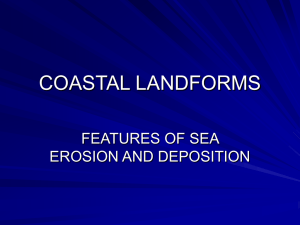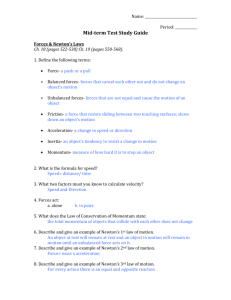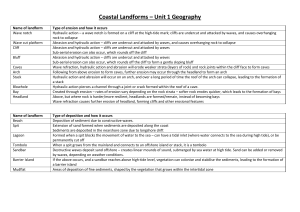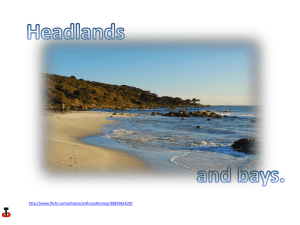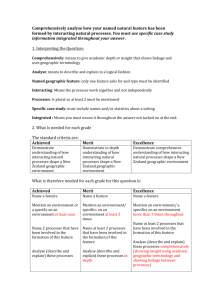3.1 What is Wrong? - Secondary Social Science Wikispace
advertisement
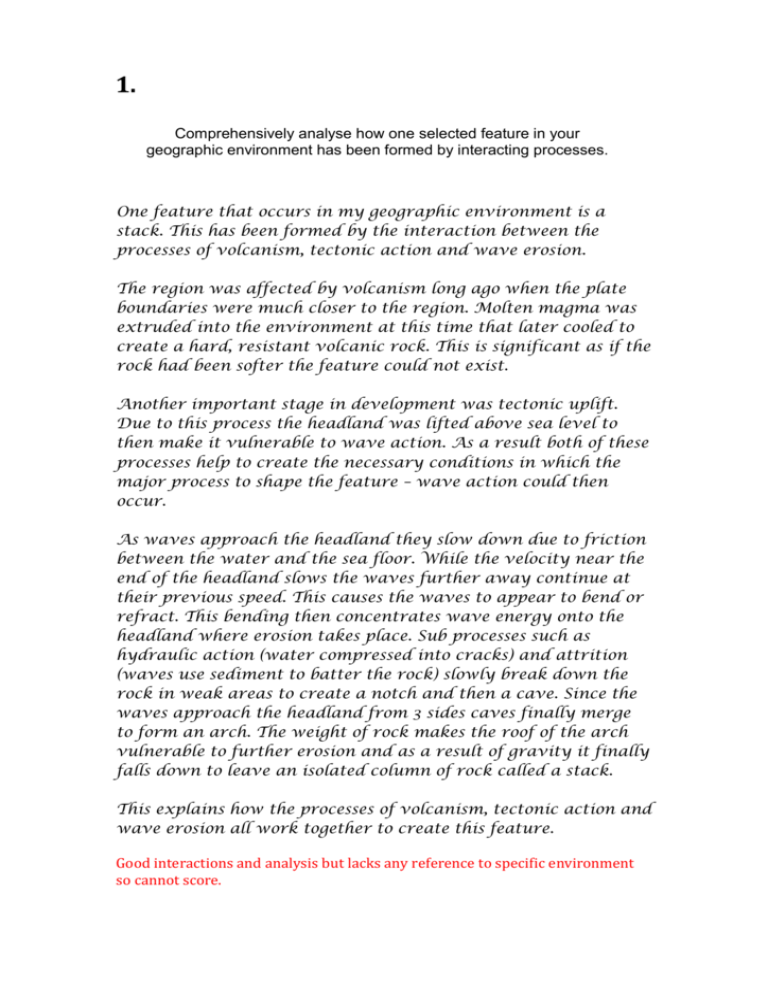
1. Comprehensively analyse how one selected feature in your geographic environment has been formed by interacting processes. One feature that occurs in my geographic environment is a stack. This has been formed by the interaction between the processes of volcanism, tectonic action and wave erosion. The region was affected by volcanism long ago when the plate boundaries were much closer to the region. Molten magma was extruded into the environment at this time that later cooled to create a hard, resistant volcanic rock. This is significant as if the rock had been softer the feature could not exist. Another important stage in development was tectonic uplift. Due to this process the headland was lifted above sea level to then make it vulnerable to wave action. As a result both of these processes help to create the necessary conditions in which the major process to shape the feature – wave action could then occur. As waves approach the headland they slow down due to friction between the water and the sea floor. While the velocity near the end of the headland slows the waves further away continue at their previous speed. This causes the waves to appear to bend or refract. This bending then concentrates wave energy onto the headland where erosion takes place. Sub processes such as hydraulic action (water compressed into cracks) and attrition (waves use sediment to batter the rock) slowly break down the rock in weak areas to create a notch and then a cave. Since the waves approach the headland from 3 sides caves finally merge to form an arch. The weight of rock makes the roof of the arch vulnerable to further erosion and as a result of gravity it finally falls down to leave an isolated column of rock called a stack. This explains how the processes of volcanism, tectonic action and wave erosion all work together to create this feature. Good interactions and analysis but lacks any reference to specific environment so cannot score. 2. Comprehensively analyse how one selected feature in your geographic environment has been formed by interacting processes. My geographic environment is South Muriwai which is located 40 km NW of Auckland Central and extends from Okiritoto stream in the north to Maori Bay in the south, a distance of approximately 5km. One feature that occurs in this environment is a stack called Mototara Island. This feature is about 50m high and is located approximately 20 metres SW of the Otakamiro headland to which it was once attached. It is formed of a conglomerate rock called a breccia which is sandstone with volcanic intrusions. It was mainly formed by different wave processes. Waves at Muriwai are very high averaging 1.5m all year but reaching over 5m in the winter. The waves hit the Otakamiro headland where they form a hole. This widens into a cave such as the large one found on the north side of the headland accessed from the wave cut platform called fisherman’s Rock. Similar caves form on the south side of the headland which then merge to form an arch. The roof of the arch then collapses to leave behind a column of rock or the stack. Eventually this will get eroded even more by the waves to finally cause a stump. You can tell that these processes are happening today since there is evidence of a stump close by. The stack is presently the site of over 5,000 pairs of gannets that nest here from October until March and which attract numerous visitors to the region. These birds further erode the stack through bird poo or guano. As a result both the waves and the gannets have formed the shape of the stack today. While this has some good specific information the answer lacks any analysis as is descriptive only. Need to say HOW the processes work to score. 3. Comprehensively analyse how one selected feature in your geographic environment has been formed by interacting processes. The Morotara stack is a significant feature that occurs in the south Muriwai coastal environment (SMCE) located 40km NW of Auckland and which extends for Okiritoto stream in the north to Maori bay in the south. 17 million years ago volcanic activity occurred in this environment with the production of large underwater volcanoes. This is because of the Pacific plate subducting below the Indo-Australian plate close by and allowing magma to escape in weak spots below the Muriwai region. They created the hard rock that forms the stack. Muriwai experiences high energy waves due to the large 2,000km fetch across the Tasman sea and the prevailing SW winds that blow over 11 knots 75% of the time. As these waves approach the beach they slow down and bend to concentrate their energy on the Otakamiro headland. Wave erosion happens when the waves attack the hard rock. The water gets compressed into cracks splitting them apart. Sediment held in the waves is hurled at the rock and further breaks it down. This results in a notch and then a cave. Caves either side of the Otakamiro headland then merge to form an arch. The roof of the arch is susceptible to erosion so gravity causes this to collapse leaving behind a column of rock or the Mototara stack as seen today. This explains how the stack has been formed by volcanism and wave action. Good specific information and analysis but there is no interaction between the processes provided so cannot score. 4. Comprehensively analyse how one selected feature in your geographic environment has been formed by interacting processes. A big feature that exists at Muriwai is a stack that was once part of the headland nearby. Huge big waves come into the environment across the ocean. As they get closer to the headland they slow down as they hit shallow water and bend and crash into it causing erosion. Bits of sand inside the waves are used like sandpaper and rub against the rock to break it down. At the same time water is pushed into small cracks and make them bigger. This will then turn into a cave. Several caves will meet allowing even more water to rush in and erode them. Eventually the roof above becomes unsteady as the rock is so heavy so it falls down. This leaves the stack on its own separate from the headland like an island. It is called the Mototara Island. Waves keep attacking the part of the island below sea level. At the same time another process is also happening which is called wave splash. The waves splash up the rock and wet it. When it dries out salt is left behind and the salt eats the rock and weakens it. The top of the stack is home to thousands of gannets. When these gannets poo the chemicals in it also break the rock down more. As a result the processes of wave erosion, wave splash and bird poo action together help to make the stack the shape it is today. This answer while not good has enough specific information and analysis (reasons for the processes and how they work) and implies interaction to allow achievement. It lacks any technical knowhow or terminology to allow any higher.

